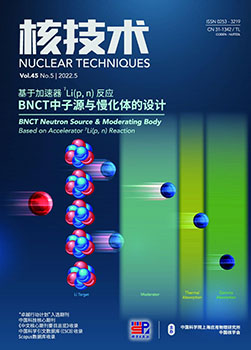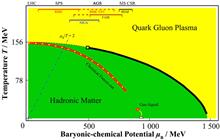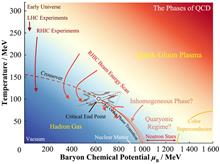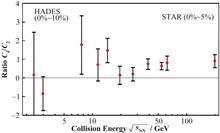
Experimental evidences at the relativistic heavy ion collisions (RHIC) and large hadron collider (LHC) have demonstrated the formation of quark gluon plasma (QGP) in ultra-relativistic heavy-ion collisions at a small baryon chemical potential, where the phase transition from hadronic matter to QGP is suggested to be a crossover from state-of-the-art lattice quantum chromodynamics (QCD) calculations. It has been conjectured that there is a first-order phase transition and a critical point at a finite μB region in the QCD phase diagram. This study reviewed recent progress in searching for the QCD critical point from RHIC-STAR experiments.
Recent progress in studies on quantum chromodynamics (QCD) phase transition and related critical phenomena within the functional renormalization group (fRG) approach were reviewed, including the nonperturbative critical exponents and baryon number fluctuations, which are pertinent to the critical end point (CEP) in the QCD phase diagram. The fRG is a nonperturbative continuum field approach, in which quantum thermal fluctuations are successively integrated with the evolution of the renormalization group (RG) scale. Different methods of finding solutions to the flow or fixed-point equations of a nonperturbative effective potential have been discussed, for example, the Taylor expansion, expansion of the spatial dimension ε=4-d, and the recently proposed direct solution of the global potential. Furthermore, the baryon number of fluctuations is relevant to the critical phenomena of the CEP. Both have been discussed, and one explores the underlying reasons for the observed non-monotonic dependence of the kurtosis of the net proton number of distributions on collision energy in experiments.
Several experiments are being conducted at heavy-ion colliders around the world to determine the location of the proposed critical end point of quantum chromodynamics (QCD) in the T-μB phase diagram. As the presence of a very strong magnetic field is relevant to peripheral heavy-ion collisions, magnetars, and the early Universe, it is important to investigate the effect of a high magnetic field strength on QCD phase diagrams. We summarize the recent status and new developments in studies investigating QCD phase transitions under an extremely strong magnetic field. By doing so, we believe that this work will promote both theoretical and experimental research in this field. TheT-B phase diagrams are produced by Lattice QCD simulations. Other phase diagrams (E-B, μB-B,μI-B, andΩ-B) are mainly studied by using the chiral effective Nambu Jona-Lasinio model. A rotating magnetic field is adopted for the study of color superconductivity. The Ginzburg-Landau approximation is used to studyπ-superfluidity andρ-superconductivity in a very strong magnetic field. Physical effects, besides a magnetic fieldB, can also be measured when sketching a QCD phase diagram, such as temperatureT, strong electric fieldE, chemical potentialsμ, and rotational angular velocityΩ. We present five QCD phase diagrams: T-B,E-B, μB-B,μI-B, andΩ-B. The following phases are present in many (if not all) of the five QCD phase diagrams: chiral symmetry breaking, chiral symmetry restoration, inhomogeneous chiral phase, π0-condensation,π-superfluidity,ρ-superconductivity, and color superconductivity. The running of the coupling constant with magnetic field is consistent with the decrease of the pseudo-critical deconfinement temperature, providing a natural explanation for the inverse magnetic catalysis effect. We also found that a chiral anomaly induces pseudoscalar condensation in a parallel electromagnetic field, and that there appears to be a chiral-symmetry restoration phase in theE-B phase diagram. Without consideration of confinement, color superconductivity is typically favored for large baryon chemical potential; however, chiral density wave is also possible in the largeB and relatively smallμB region of the phase diagram. In an external magnetic field, theπ-superfluid with finite isospin chemical potential acts similarly to a Type-II superconductor with finite electric chemical potential. Bothπ-superfluidity andρ-superconductivity are possible in a parallel magnetic field and rotation, but the latter is more favored for largerΩ particles.
The exploration of the critical point on the QCD (Quantum Chromodynamics) phase diagram is one of the most important goals of the beam energy scan program in relativistic heavy-ion collisions (RHIC-BES). Preliminary experimental measurement observed the non-monotonic behavior of net-proton fluctuations as a function of collision energy, which qualitatively agrees with the prediction of the static theoretical models and this hints the existence of the QCD critical point. The system created in heavy-ion collision is highly expanding system with which the dynamical effects dramatically modify the critical fluctuations near the QCD critical point. To confirm the existence of QCD critical point and study the phase structure of QCD system at finite temperature and finite density region, a series of dynamical models near the QCD critical point has been developed. This paper reviews the recent developments related to the exploration of the QCD critical point from experimental and theoretical viewpoints. In particular, we emphasize on the developments and challenges of the dynamical model near the QCD critical point and the first-order phase transition.
One of the main goals of relativistic heavy-ion collision (HIC) is to search for the critical end point (CEP) of quantum chromodynamics (QCD), and distribution of the net-proton number from experimental measurements shows non-monotonic behavior, which indicates the existence of a CEP. The purpose of this work is to investigate the relationship between the net-proton number fluctuation and collision energy, and to explain the experimentally measured behavior. This study investigates the three-flavor Polyakov-loop Nambu-Jona-Lasinio (PNJL) model, which contains quark degrees from the NJL (Nambu-Jona-Lasinio) model and effective gluon contributions from Polyakov-loop, based on the equilibrium assumption and mean-field approximation. In addition, we study the phase diagram and C4/C2 of baryon number fluctuation as a function of collision energy along the freeze-out lines fitted from experimental data. With an appropriate form of freeze-out line, the collision energy decreases in the region of 7.7~200 GeV, and C4/C2 decreases slightly then increases, which is in agreement with the experimental data. Additionally, these results indicate that the equilibrium assumption is appropriate for the exploration of the system evolution after HIC, and the relationship between the freeze-out and phase transition lines is highly sensitive for observables.
The goal of relativistic heavy-ion collisions is to determine the phase boundary of quantum chromodynamics (QCD) phase transitions. Critically sensitive observables are suggested to be higher-order cumulants of conserved charges. The non-monotonous behavior of higher cumulants was observed at the relativistic heavy-ion collider (RHIC). However, it remains unclear whether these non-monotonous behaviors are critically related. We studied the influences of non-critical fluctuations, finite system size, and limited evolution time to determine if they cause non-monotonous behavior. First, we examined the minimum statistics required for measuring the fourth cumulant. The minimum statistic obtained using the centrality bin width correction (CBWC) method was 25 M. We suggest using a 0.1% centrality bin in the CBWC method instead of each Nch. With a 0.1 centrality bin width, 1 M statistics are sufficient. We then pointed out the statistical fluctuations from the limited number of final particles. By assuming the independent emission of each positive (or negative) charged particle, the statistical fluctuations of positive (or negative) charged particles were presented by a Poisson distribution, and the statistical fluctuations of net-charged particles were their evolution. The obtained statistical fluctuations for net protons, net electronic charges, and net baryons were consistent with those from the Hadron Resonance Gas model. In addition, the measured cumulants at RHIC/STAR are dominated by these Poisson-like statistical fluctuations. At the end of this section, we suggest the pooling method of mixed events and demonstrate that the sample of mixed events accurately presents the contributions of the background. Dynamic cumulants were defined as the cumulant of the original sample minus that of the mixed sample. Dynamical cumulants were shown to simultaneously reduce the influence of the statistical fluctuations, centrality bin width effects, and detector efficiency. Second, because the system is finite, the correlation length at the critical point is not developed to infinity in contrast to the system at thermal limits. Using a Monte Carlo simulation of the three-dimensional three-state Potts model, we demonstrated the fluctuations of the second- and fourth-order generalized susceptibilities near the temperatures of the external fields of the first-, second-, and crossover regions. Both the second- and fourth-order susceptibilities showed similar peak-like and oscillation-like fluctuations in the three regions. Therefore, non-monotonic fluctuations are associated with the second-order phase transition and the first-order phase and crossover in a finite-size system. The exponent of finite-size scaling (FSS) characterizes the order of transitions or crossover. To determine the parameters of the phase transition using the FSS, we studied the behavior of a fixed point in the FSS. To quantify the behavior of the fixed point, we define the width of the scaled observables of different sizes at a given temperature and scaling exponent ratio. The minimum width reveals the position of the fixed point in the plane of the temperature and scaling exponent ratio. The value of this ratio indicates the nature of the fixed point, which can be a critical, first-order phase transition line point, or crossover region point. To demonstrate the effectiveness of this method, we applied it to three typical samples produced by a three-dimensional three-state Potts model. The results show that the method is more precise and effective than conventional methods. Possible applications of the proposed method are also discussed. Finally, because of the limited evolution time, some processes in relativistic heavy-ion collisions may not reach thermal equilibrium. To estimate the influence of the nonequilibrium evolution, we used the three-dimensional Ising model with the Metropolis algorithm to study the evolution from nonequilibrium to equilibrium on the phase boundary. The order parameter exponentially approaches its equilibrium value, as suggested by the Langevin equation. The average relaxation time is defined. The relaxation time is well represented by the average relaxation time, which diverges as the zth power of the system size at a critical temperature, similar to the relaxation time in dynamical equations. During nonequilibrium evolution, the third and fourth cumulants of the order parameter could be positive or negative depending on the observation time, which is consistent with the calculations of dynamical models at the crossover side. The nonequilibrium evolution at the crossover side lasts briefly, and its influence is weaker than that at the first-order phase transition line. These qualitative features are instructive for experimentally determining the critical point and phase boundary in quantum chromodynamics.
We aim to study the effects of chemical potential and angular velocity on the critical endpoint of quantum chromodynamics (QCD). We used several probes (drag force, jet quenching parameter, heavy vector meson spectral function) to characterize the phase transition and studied gravitational waves from the holographic QCD phase transition in the early universe. We used different holographic QCD models to discuss the QCD phase transition, energy loss, spectral function, and gravitational waves. We found that the chemical potential and angular velocity changed the location of the critical endpoint, and the drag force and jet quenching parameter were temperature dependent and enhanced near the phase transition temperature. The magnetic field had a nontrivial effect on the spectral function. We conclude that the chemical potential decreases ωc, and the angular velocity decreases μc and the phase transition temperature. The jet quenching parameter and drag force can characterize the phase transition, and the magnetic field promotes the dissociation of heavy vector mesons. Moreover, the energy density of gravitational waves decreases as the gluon condensate increases, and the peak frequency shifts downward with increasing gluon condensate.Exploring the phase structure of QCD is an important task in high-energy heavy ion collision physics, and recently, there has been considerable interest in the QCD phase transition for rotating backgrounds.
We review the current status of quantum chromodynamics (QCD) properties in strong magnetic fields from lattice QCD. After a general introduction, we briefly present the implementation of a background magnetic field onto a lattice and discuss the recent progress on QCD properties at zero temperature, QCD transition temperature and inverse magnetic catalysis, and QCD phase structure in strong magnetic fields. Finally, we summarize this study.
The quantum chromodynamics (QCD) phase diagram is of great interest to researchers in the field of high energy nuclear physics. We review the present research status of several aspects of this topic. This review includes the search for the phase transition mechanism resulting in high-order baryon number fluctuations, how chiral imbalance, finite volume, and under rotations affect the QCD diagram, and the applications of the equation of states of dense QCD matter in the study of compact stars. The Nambu-Jona-Lasinio model and Dyson-Schwinger equations approach are the most commonly used methods described in this review. It is found that the theoretical results of high-order baryon number fluctuations are in good agreement with the experimental data. The chiral imbalance, finite volume, and rotation of quark-gluon plasma (QGP) have a quantitative impact on the chiral condensate and the QCD phase structure. In the study of compact stars, the theoretical results from equation of states of dense QCD matter agree well with pulsar observations. Further research will be required to form a complete understanding of the QCD phase diagram, particularly given the abundance of QGP.
Exploring the quantum chromodynamics (QCD) phase diagram at finite bayron density regime through the beam energy scan (BES) program at the relativistic heavy-ion collider (RHIC) is one of the key frontiers in high energy nuclear physics. The high precision data anticipated from the second phase of the BES program would potentially enable the discovery of the conjectured QCD critical point, a landmark point on the phase diagram. In this paper, the progress made by the beam energy scan theory (BEST) collaboration, which was formed with the goal of providing a theoretical framework for analyzing data from BESII, is reviewed. In addition, the challenge of investigating the QCD phase diagram with future facilities is discussed.
Understanding the phase structures of strong interaction matter is an active frontier in nuclear physics research currently, and it will provide crucial insights into heavy-ion collision experiments as well as neutron star observations. Most studies in this area focus on the influence of extremely high temperatures and baryon densities on matter properties, especially pertaining to phase transitions such as the chiral symmetry breaking and color superconductivity. Recent experimental and theoretical studies reported that in non-central heavy-ion collisions, systems carry a large initial angular momentum that becomes very strong vorticity fields in the bulk fluid. This has thus introduced several new questions regarding the properties of strong interaction matter under vorticity fields, and have led to many novel results. Thermal field theory calculations based on rotating frame and mean-field approximation have been developed to study various phase transitions under rotation, such as chiral symmetry breaking, color superconductivity and superfluidity at high isospin asymmetry. The results have demonstrated important impacts of vorticity fields on the phase boundaries of these transitions, and have also revealed nontrivial new phase structures of strong interaction matter under rotation. A new dimension of the usual QCD phase diagram has been unveiled. The study of rotation-induced phase transition extends phase transition research to a broader space. There remain more unexplored issues that merit further study.
The searching for potential quantum chromodynamics (QCD) phase transition signals is a fundamental goal of on-going experiments on heavy-ion collisions, which is critical to understanding the properties of strongly interacting matter under extreme conditions, the inner structure of compact stars, gravitational waves emitted from neutron star mergers, etc. In particular, the beam energy scan program carried out at the Relativistic Heavy-Ion Collider (RHIC) provides a unique tool that enables studies into the QCD phase diagram and the conjectured QCD critical point. Besides the event-by-event fluctuation of conserved charges, which has been widely accepted as a useful study of the QCD critical point, the production of light nuclei can serve as a sensitive observable to the QCD phase transitions in high-energy heavy-ion collisions. The density fluctuation and correlation among nucleons are automatically encoded in the production of light nuclei in heavy-ion collisions. This study aims to demonstrate how to probe QCD phase transition with light nuclei production in heavy-ion collisions. The progress of studies in this area over the last few years is reviewed. The nucleon coalescence model provides a suitable tool for the study of the effects of density fluctuation/correlation on light nuclei production. A transport model based on the Nambu-Jona-Lasinio (NJL) model is developed to simulate the occurrence of the first-order chiral phase transition in heavy-ion collisions. Within the coalescence model for light nuclei production, the yield ratio NtNp/Nd2 of protons (p), deuterons(d), and tritons (t) is shown to be sensitive to the nucleon density fluctuation and correlation and can function as a good probe to the non-smooth QCD phase transition. The production of light nuclei in heavy-ion collisions encodes the information about baryon density fluctuations and correlations, and enhancements of the yield ratioNtNp/Nd2 could serve as an indicator for the occurrence of a first-order or second-order QCD phase transition.
The RHIC-STAR (Relativistic Heavy Ion Collider-Solenoid Tracker at RHIC) experiments have measured the cumulants of net-proton (a proxy for net-baryon), net-charge, and net-kaon (proxy of net-strangeness) multiplicity distributions in Au+Au collisions at different centers of mass with energies ranging from 7.7 GeV to 200 GeV. Recent results have shown that the ratio of the fourth-order net-proton cumulant over the second-order one (κσ2) exhibits a nonmonotonic energy dependence. In relativistic heavy-ion collision experiments, only information about the final state particles can be measured. Therefore, we investigated the fluctuations of the conserved charges (baryon, electric charge, and strangeness) in Au+Au collisions using a multiphase transport (AMPT) model. This model can basically describe the results measured by the RHIC-STAR experiment. More importantly, the AMPT model is used to understand the key impacts of the dynamical evolution of relativistic heavy-ion collisions on fluctuations and correlation functions, including the creation and diffusion of conserved charges, hadronization, hadronic rescatterings, and weak decays. It was discovered that the correlation between positive and negative charges may originate from the string melting mechanism. Baryon (proton) correlation functions are consistent with the expectation of baryon number conservation. Net-strangeness (net-kaon) originates from pair production. We studied the correspondence between representative quantities and their conserved charges and found that their behaviors are qualitatively consistent yet quantitatively different. Although the physics of quantum chromodynamics (QCD) critical fluctuations is not included in the AMPT model, our results are expected to provide a baseline for the search of possible critical behavior at the QCD critical end point in relativistic heavy-ion collisions. We incorporated critical density fluctuations into the model and found that they play a role.
In high-energy heavy ion collisions, quarks and gluons are released from the colliding nucleus to form a new state of nuclear matter called deconfined quark gluon plasma (QGP). To study the transition from normal nuclear matter or hadron resonance gas to QGP, non-perturbative quantum chromodynamics (QCD) must be solved on supercomputers using the lattice numerical method (lattice Quantum Chromodynamics, lattice QCD). However, lattice QCD only works for zero and small baryon chemical potential regions that can be described by the Taylor expansion and provides the nuclear equation of state (EoS) and QCD transition in these regions. For large baryon chemical potential regions that cannot be described by the Taylor expansion, lattice QCD fails to provide the nuclear EoS and QCD transition owing to the famous sign problem. Machine learning helps to study the nuclear EoS and QCD phase transition. First, machine learning can determine the nuclear EoS and QCD transition using the momentum distribution of final state hadrons in heavy-ion collisions, with data from both heavy-ion collision experiments and relativistic hydrodynamic simulations. Second, it can contribute to the direct solution of the sign problem in lattice QCD. The present paper reviews the applications of machine learning to the study of the QCD phase transition in heavy-ion collisions. This study (1) introduces nuclear EoS and QCD transition as well as the difficulty of the lattice QCD method, (2) analyzes the nuclear EoS using Bayesian analysis, (3) identifies the nuclear EoS and QCD phase transition using different types of deep neural networks (e.g., convolutional neural network, point cloud network, and many-event averaging), (4) searches for critical self-similarity using a dynamical edge convolution-based graph neural network, (5) learns the quasi-particle mass using a physically informed network and auto-differentiation, (6) discards unphysical regions in the nuclear EoS with a critical endpoint using active learning, (7) discusses unsupervised learning for the nuclear liquid-gas phase transition, (8) determines the nuclear symmetry energy in heavy-ion collisions, (9) investigates Mach cones using deep learning assisted jet tomography, and (10) accelerates the sampling of lattice QCD configurations using a physically constrained neural network while solving the sign problem in lattice QCD using deep learning.
The use of the relativistic heavy ion collision experiment has extended our insights into the diverse possibilities available to a truly strongly-interacting system. The main goal of this experiment is to describe the properties of the different phases of quantum chromodynamics (QCD) and to chart the QCD phase diagram on the T-mu plane. For the phase diagram, apart from the general phase boundary lines, some specific characteristics such as the possible critical endpoint (CEP), associated coexistence region, and strongly-coupling quark-gluon plasma (sQGP) have to be identified. Here, the CEP separates the first-order phase transition from the second-order transition (or crossover) when the case beyond the chiral limit is considered. However, convincing signals have not yet been obtained using the relativistic heavy ion collider (RHIC) experiment. Theoretically, strong interaction systems hold significant features: asymptotic freedom in the ultraviolet region, dynamical chiral symmetry breaking, and confinement in the infrared region. Such features can be uniformly displayed in the phase structure of the matter in the temperature T and chemical potential planes. Consequently, several investigations have been experimentally and theoretically performed. However, the strong coupling feature in the low-energy region prevents the use of perturbative calculation methods, which creates the need for the development of nonperturbative approaches. Additionally, lattice QCD simulations have been widely implemented; however, the "sign problem" delays the progress in the large chemical potential region. Therefore, the Dyson-Schwinger equation (DSE) equation method and functional renormalization group approach, which inherently include both dynamical chiral symmetry breaking (DCSB) and confinement, play an important role. The QCD DSE approach is a method based on the continuum quantum field theory. The new criteria were proposed based on the DSE and studied using the deconfinement and Chiral symmetry restoration phase transition of QCD. Currently, functional methods can be used to provide a reliable estimation of the CEP location. First, reliability is achieved using a thorough investigation of the truncation of the DSE, state of the art truncation is then performed causing a converging result between the different methods, and the predication of the lattice simulation at low chemical potential is confirmed. The results show a fast convergence of the truncation owing to the infrared fixed point of the QCD coupling, which allows the capturing of the QCD running behavior using a finite set of two- and three-point Green functions. The estimated location of the CEP based on the current computation is μB at 600~650 MeV and T at 100~110 MeV. The existing functional QCD methods are non-perturbative continuum methods that are capable of simultaneously describing both the DCSB and confinement. Although they are limited by the truncations, the use of functional QCD approaches has resulted in progress in the study of the QCD phase structure and thermal properties, where a complete phase diagram and related thermal properties have been obtained in a large chemical potential range, which can provide a reference for the exploration of the QCD features. Most of the theoretical studies using effective models or certain truncations have observed the existence of the CEP; however, the determination of its location is still a work in progress because it varies based on the computation. Moreover, searching for QCD phase transition signals, particularly the CEP, is the main goals of current and future experimental programs on the relativistic heavy ion collider.














